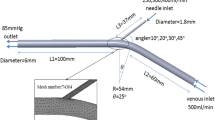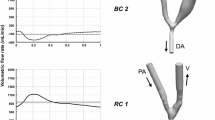Abstract
Generally, the hemodialysis patient with the prosthetic arteriovenous graft (AVG) undergoes two punctures with needles on the graft in every dialysis session. As an alternative method for patients with AVGs, clinicians and nurses often return the blood filtered by a dialysis machine to an autologous vein not the graft, and that is defined as a separate cannulation method. In this study, we numerically evaluate the influence of the separate cannulation method on the hemodynamics by using clinical information of six patients. In the results, when the separate cannulation method is used, the low time-averaged wall shear stress region increases whereas the high oscillatory shear index region decreases at the venous anastomosis and proximal vein. The quantitative analysis using hemodynamic index indicates the separated cannulation method has pros and cons on the occurrence of complications in AVGs.
Similar content being viewed by others
References
J. D. Kopple, National kidney foundation K/DOQI clinical practice guidelines for nutrition in chronic renal failure, American Journal of Kidney Diseases, 37 (1) (2001) S66–S70.
K. David and C. A. Robert, Vascular grafts, in The Biomedical Engineering Handbook, Second Edition, 2 Volume Set, CRC Press (1999).
H. P. Greisler, New biologic and synthetic vascular prostheses, RG Landes Company Austin, TX (1991).
G. A. Beathard, The treatment of vascular access graft dysfunction: a nephrologist’s view and experience, Adv. Ren. Replace Ther., 1 (2) (1994) 131–47.
P. Roy-Chaudhury et al., Venous neointimal hyperplasia in polytetrafluoroethylene dialysis grafts, Kidney Int., 59 (6) (2001) 2325–34.
P. Roy-Chaudhury, V. P. Sukhatme and A. K. Cheung, Hemodialysis vascular access dysfunction: a cellular and molecular viewpoint, J. Am. Soc. Nephrol., 17 (4) (2006) 1112–27.
Z. Twardowski and H. Kubara, Different sites versus constant sites of needle insertion into arteriovenous-fistulas for treatment by repeated dialysis, Dialysis & Transplantation, 8 (10) (1979).
Z. Twardowski, R. Lebek and H. Kubara, 6-Year experience with the creation and use of internal arteriovenous fistulae in patients treated with repeated hemodialysis, Polskie Archiwum Medycyny Wewnętrznej, 57 (3) (1977) 205.
M. R. Chan et al., The effect of buttonhole cannulation vs. rope-ladder technique on hemodialysis access patency, Semin. Dial., 27 (2) (2014) 210–216.
H. Haruguchi and S. Teraoka, Intimal hyperplasia and hemodynamic factors in arterial bypass and arteriovenous grafts: a review, J. Artif. Organs., 6 (4) (2003) 227–235.
K. Van Canneyt et al., Experimental study of a new method for early detection of vascular access stenoses: pulse pressure analysis at hemodialysis needle, Artif. Organs., 34 (2) (2010) 113–7.
T. A. Salam et al., Low shear stress promotes intimal hyperplasia thickening, Journal of Vascular Investigation, 2 (1) (1996) 12–22.
F. P. Glor et al., Reproducibility study of magnetic resonance image-based computational fluid dynamics prediction of carotid bifurcation flow, Ann. Biomed. Eng., 31 (2) (2003) 142–51.
C. G. Nevaril et al., Erythrocyte damage and destruction induced by shearing stress, J. Lab. Clin. Med., 71 (5) (1968) 784–90.
G. Helmlinger et al., Effects of pulsatile flow on cultured vascular endothelial cell morphology, J. Biomech. Eng., 113 (2) (1991) 123–31.
R. M. Nerem, M. J. Levesque and M. Sato, Vascular dynamics and the endothelium, in Frontiers in Biomechanics, G. W. Schmid-Schönbein, S. L. Y. Woo and B. W. Zweifach, Editors, Springer New York (1986) 324–341.
S. Hyun, C. Kleinstreuer and J. P. Archie, Computational particle-hemodynamics analysis and geometric reconstruction after carotid endarterectomy, Comput. Biol. Med., 31 (5) (2001) 365–84.
J. J. Chiu and S. Chien, Effects of disturbed flow on vascular endothelium: pathophysiological basis and clinical perspectives, Physiol. Rev., 91 (1) (2011) 327–87.
D. N. Ku et al., Pulsatile flow and atherosclerosis in the human carotid bifurcation. Positive correlation between plaque location and low oscillating shear stress, Arteriosclerosis, 5 (3) (1985) 293–302.
A. Kamiya and T. Togawa, Adaptive regulation of wall shear stress to flow change in the canine carotid artery, Am. J. Physiol., 239 (1) (1980) H14–21.
C. K. Zarins et al., Shear stress regulation of artery lumen diameter in experimental atherogenesis, J. Vasc. Surg., 5 (3) (1987) 413–420.
I. Van Tricht et al., Comparison of the hemodynamics in 6mm and 4-7 mm hemodialysis grafts by means of CFD, J. Biomech., 39 (2) (2006) 226–236.
Y. I. Cho and K. R. Kensey, Effects of the non-Newtonian viscosity of blood on flows in a diseased arterial vessel. Part 1: Steady flows, Biorheology, 28 (3-4) (1991) 241–262.
B. M. Johnston et al., Non-Newtonian blood flow in human right coronary arteries: steady state simulations, Journal of Biomechanics, 37 (5) (2004) 709–720.
S. W. Lee, L. Antiga and D. A. Steinman, Correlations among indicators of disturbed flow at the normal carotid bifurcation, J. Biomech. Eng., 131 (6) (2009) 061013.
X. He and D. N. Ku, Pulsatile flow in the human left coronary artery bifurcation: average conditions, J. Biomech. Eng., 118 (1) (1996) 74–82.
Author information
Authors and Affiliations
Corresponding author
Additional information
Recommended by Associate Editor Won Hyoung Ryu
Kun Hyuk Sung obtained his B.S. and M.S. degrees in Mechanical Engineering, Chung-Ang University, Seoul, Korea in 2008 and 2013, respectively. He is a Ph.D. candidate in School of Mechanical Engineering at Chung-Ang University, Seoul, Korea.
Hyangkyoung Kim obtained her B.S. degree in Medicine from Pusan National. University. She obtained M.S. and Ph.D. degrees in Medicine from Ulsan University. She is a professor of Medicine in Chung-Ang University Hospital, Seoul, Korea.
Hong Sun Ryou obtained his B.S. and M.S. degrees in Aeronautical Engineering from Seoul National University. He obtained Ph.D. degree in Aeronautics from Imperial College, London, UK. He is a professor in School of Mechanical Engineering, Chung-Ang University, Seoul, Korea.
Rights and permissions
About this article
Cite this article
Sung, K.H., Kim, H. & Ryou, H.S. Numerical study on the effect of separate cannulation method on hemodynamics in an arteriovenous graft. J Mech Sci Technol 30, 963–970 (2016). https://doi.org/10.1007/s12206-016-0151-4
Received:
Revised:
Accepted:
Published:
Issue Date:
DOI: https://doi.org/10.1007/s12206-016-0151-4




